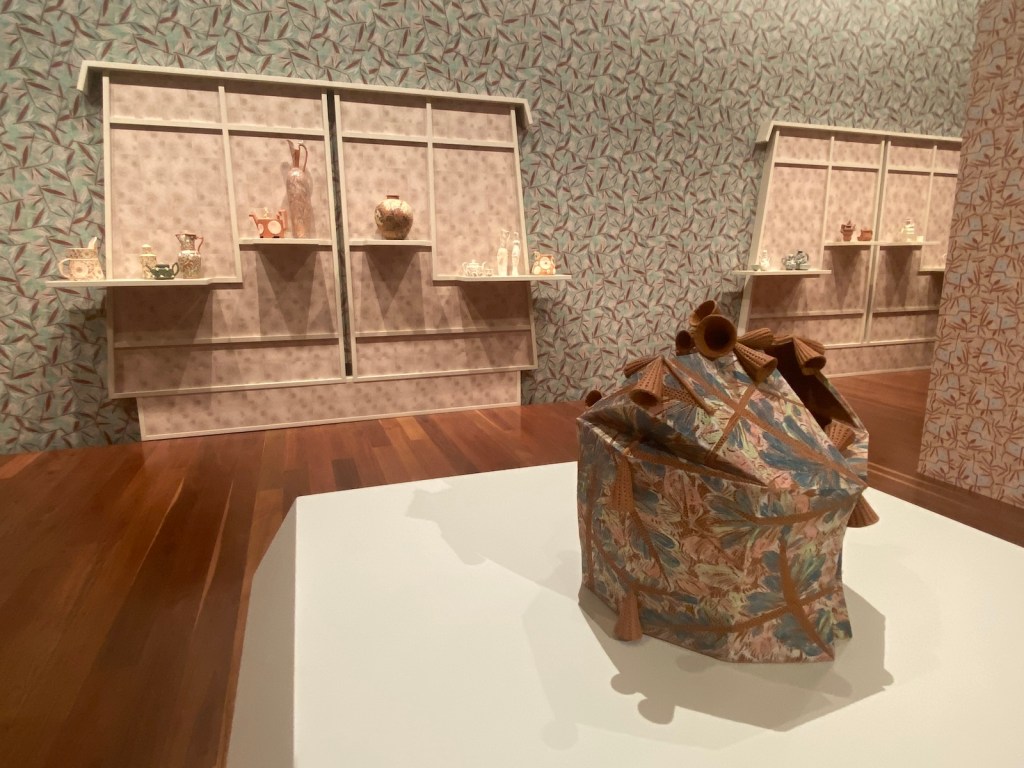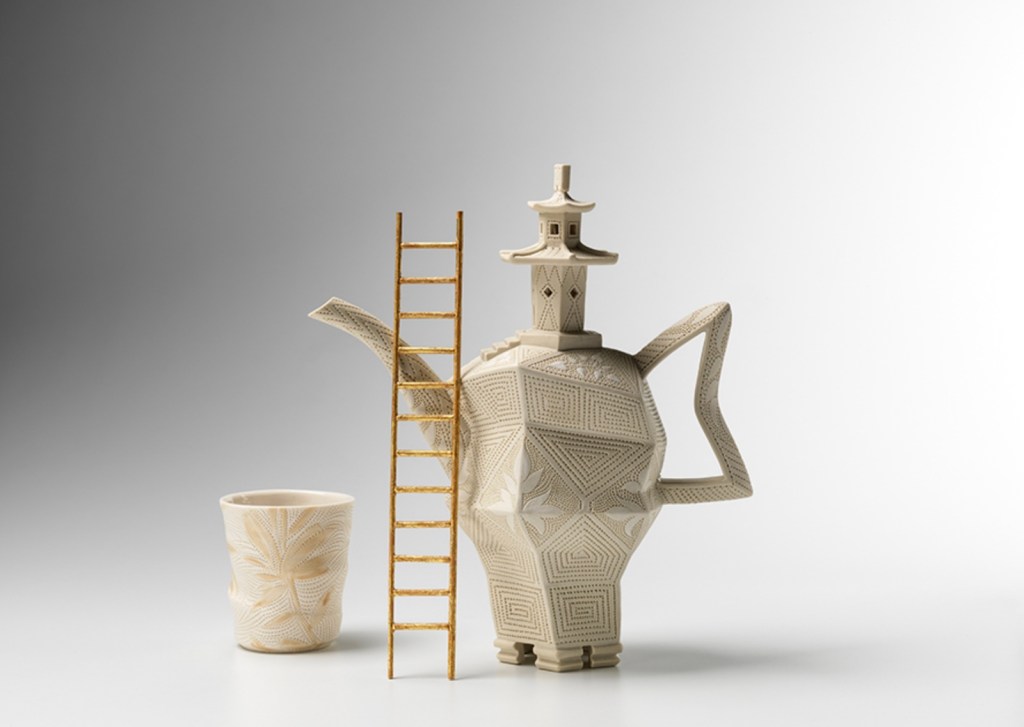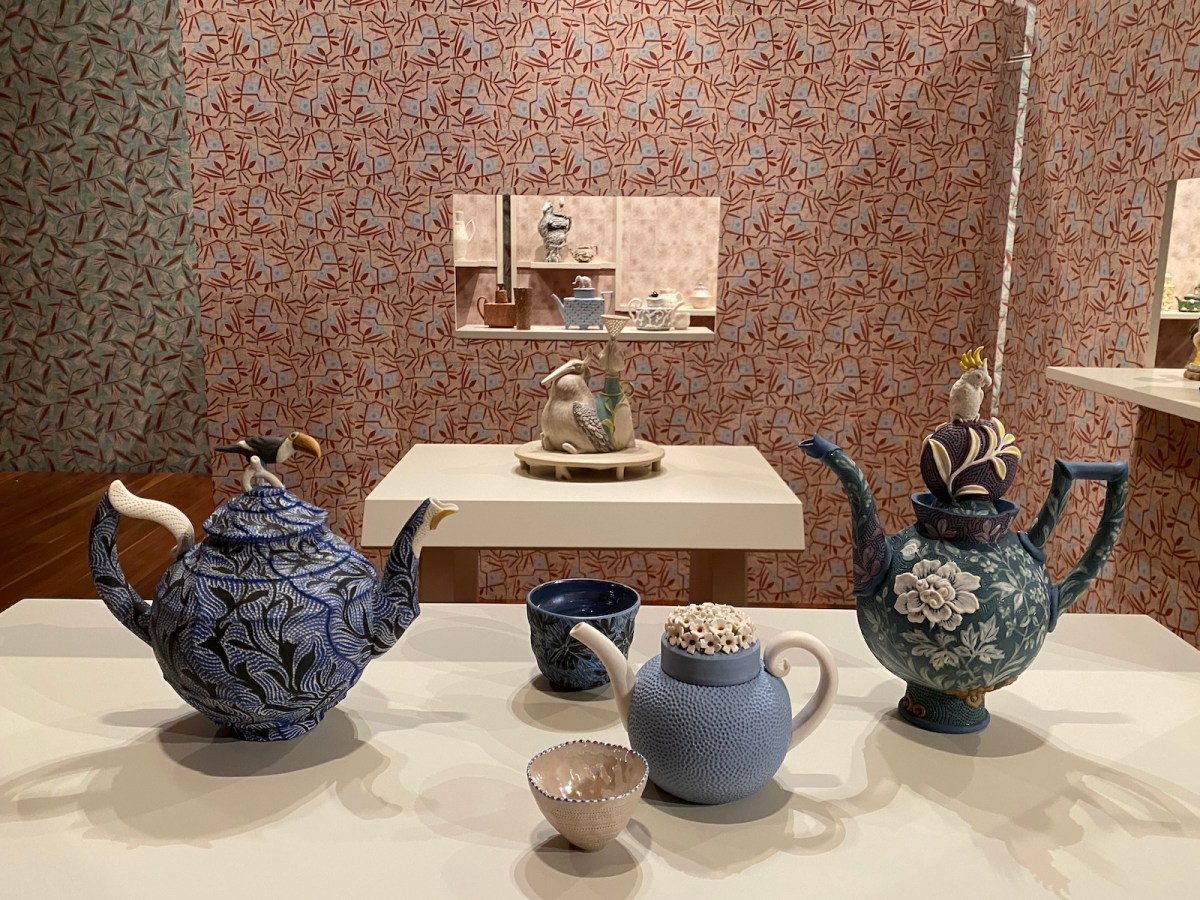Bruce Nuske has been a maker and a teacher of ceramics for more than 50 years. With that comes incredible dexterity – both in terms of skill, but also in his nimble grasp of art history.
Nuske’s current exhibition at Samstag Museum of Art is a masterly show of such dexterity, and is also laced with doses of charm and humour.
Partnering with the late architect and designer Khai Liew, Nuske’s exhibition was originally planned before Liew’s death, but Samstag was unfortunately flooded and faced a prolonged closure. As the first exhibition on its reopening, it is a bittersweet moment that Liew is unable to experience their shared vision.
Maximalist Nuske and mininmalist Liew were great mates – an uncanny pair drawn together through their love of beautiful things and a shared drive for perfection. Every detail of this show is well-considered and planned. Wall patterns are picked up from Nuske’s surfaces and glazes, and a shared Asian aesthetic and design influence is celebrated in many of Nuske’s vessels.

It is not the first time they have collaborated; they did so in 2012 for the exhibition Irrational and Idiosyncratic (Samstag Museum of Art). And, indeed, this exhibition is the fourth in a series of exhibitions focusing on South Australian practitioners working at the intersection of craft, design and contemporary art (Helen Fuller in 2022 also worked with Liew).
Despite being collected by institutions internationally, however, a solo show at this scale is a first for Nuske. Over 50 ceramic and porcelain objects – largely teapots and tea caddies – are on display, the earliest reaching back to the early 1980s, offering an anchor to his practice, and the most recent from just a few weeks ago.
Teapots are unlikely inhabitants of a contemporary – often experimental – art space, but they work here. They are so much more than functional objects (despite all being tested, admits Nuske). Rather they are delivery devices for stories and follies, and rub shoulders with their historical counterpoints.
It is hard to convey the level of skill in this exhibition. Nuske’s pieces are impeccable on every level, and yet they are not stifled by technique. And they inspire wonder. With the artist working up to 50 hours on a piece, each is an individual artwork. Though they may be thought of as baroque opulence at times – these pieces are equally about form and proportion, seducing a kind of energy out of that form through its surface engagement.
Nuske is able to slide between, and riff off – with the grace of a chameleon – botanical motifs, to Chinoiseries and Japanese patterns and styles, giving nods to Rococo figurine, iconic Wedgewood and the Arts and Crafts Movement.
The exhibition is loosely divided into two “rooms”, with custom wall-mounts and a central table. Nuske explains they are not approached as themes or ideas, but are aesthetic clusters that make connections through colour and narratives.
Walking through the exhibition with Nuske, he lovingly relays story after story of his teapots. His encyclopaedic knowledge finds its way into each as quirky machinations – such as an imagined ruse between an ostrich and a hobo bird, which falls back in a faint in the presence of other porcelain figurines at the David Roche Foundation House Museum, where Nuske has completed a residency.
Part of Nuske’s fascination stems from the authoritative voice of the museum in the way it constructs histories, taking on a trickster role in concocting stories that dwell in the cracks between ideas of genuine and real, to misrepresentation and falsity.
While Nuske may start with a drawing of a form, these vessels are largely improvised – letting a story take a stroll if you like. They seamlessly move between hand-built and wheel-worked pieces, and techniques blend and blur. Glazes are often used sparingly, and the surfaces can be worked with fine tooling to articulate patterns.

Nuske describes one teapot as ‘some pretty fashionistas going out all dressed up’, and another as ‘a dog and a stork who fall in love with a vase of flowers’. The latter is a teapot titled Lament, which delves into a world of ageing and the inevitability that everything fades. Another, Long After the Rain, expresses a concern for Adelaide’s arid climate and water as a resource to be cherished. It is a paired bowl and pitcher riffing of the Victorian tradition, which economised water use.
Read: Exhibition review: Dana Awartani, Samstag Museum of Art, Adelaide
Each teapot has a name, as obsessively caught in narrative as they are in decoration. Do we need those narratives to appreciate this pieces? No. Even if you are not a fan of ceramics (or tea), Nuske’s works seemingly bewitch us into another world that leaves the viewer with a smile. Wonder is such a great gift.
And his favourite tea? ‘I really love drinking coffee,’ he tells ArtsHub. This exhibition is a must to see for any lover of ceramics … or tea.
Bruce Nuske, with Khai Liew
Samstag Museum of Art, Adelaide
1 March – 10 May
Free
This exhibition is part of 2024 Adelaide Festival programming. The writer travelled to Adelaide as a guest of the Festival.





